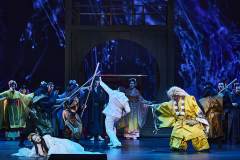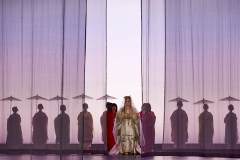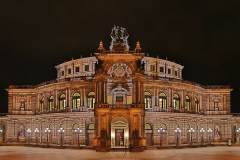Madama Butterfly
Mo | Tu | We | Th | Fr | Sa | Su |
Madama Butterfly - Giacomo Puccini
Tragedia giapponese in three acts
Libretto by Luigi Illica and Giuseppe Giacosa
Performed in Italian with German and English supertitles
Premiere: April 2, 2022
Puccini’s Madama Butterfly cannot accept that her great love is doomed to end in heartbreak.
Storyline
Act one
Nagasaki in the 1890s. A wedding is to be celebrated in the garden of a hill-side residence with view of the port: the wedding of the American marine officer B. F. Pinkerton and the 15-year-old geisha Cio-Cio-San, daughter of a samurai who has fallen out of favour. The matchmaker, Goro, explains the building design of the new residence to Pinkerton who is not familiar with this. They are joined by the American counsel in Nagasaki, Sharpless. He highlights the cultural differences to the young American and warns him not to take the marriage lightly which can be short-term according to Japanese custom. Finally, Cio-Cio-San and her family, accompanied by several geishas, enter. After the wedding, Cio-Cio-San’s uncle, the priest Bonzo, storms into the garden and denounces the bride for converting to Christianity. Pinkerton asks the angry guests to leave. Suzuki, a friend of many years of Cio-Cio-San, Pinkerton and Cio-Cio-San remain. In the evening mood, both proclaim their love to each other.
Act two
It has been three years since Pinkerton returned to his American homeland with the promise to return when the »robin’s nest« and Cio-Cio-San has been waiting patiently since then. She ignores Suzuki’s interjection that she has never heard of a foreign husband returning to his wife in Japan. Counsel Sharpless brings a letter from Pinkerton; he is to prepare her for the fact that Pinkerton has, meanwhile, married in America but Cio-Cio-Sans’s exuberance prevents him telling her this. Goro joins them and says that Cio-Cio-San should marry the well-off Yamadori as, according to Japanese law, marriage ends in divorce the moment the husband leaves his wife. Cio-Cio-San brusquely rejects Yamadori’s marriage request. She holds on to her belief in Pinkerton’s firm loyalty and American marriage law. Sharpless wants to tell Cio-Cio-San the truth but then she introduces her three-year-old son to him and asks him to tell Pinkerton about him. A canon shot announces the arrival of a ship – the long-awaited M.S. Lincoln with Pinkerton on board. In happy anticipation, Cio-Cio-San and Suzuki adorn the house with flowers. Dressed in her bridal outfit, she waits with Suzuki and her son for Pinkerton’s return. Night slowly falls.
Act three
Cio-Cio-San waited the whole night in vain. She withdraws to her bedroom with her son to sleep. Suzuki finds Sharpless and Pinkerton with his American wife Kate in front of the house. Sharpless asks Suzuki to persuade Cio-Cio-San to entrust Pinkerton’s new wife with her child. Suzuki tells Pinkerton that Cio-Cio-San waited for him for three years upon which he is overcome with guilt and flees. Cio-Cio-San appears from her bedroom and sees Kate. She suddenly grasps the situation. She responds to Kate’s request to give her the child by saying that Pinkerton should return in half an hour to collect their son. After a short conversation with Kate, she agrees to fulfil the wish of handing over her son to him. She asks to be left alone for half an hour and withdraws to her room with the intention to take her own life. She ends her life with a dagger which she kept in memory of her father – the final thing she hears is Pinkerton’s voice calling her name.
Program and cast
Cio-Cio-San: Marjukka Tepponen
Suzuki: Christa Mayer
Kate Pinkerton: Dominika Škrabalová
B.F. Pinkerton: Tomislav Mužek
Sharpless: Neven Crnić
Goro: Aaron Pegram
Fürst Yamadori: Sebastian Wartig
Uncle Bonzo: Oleksandr Pushniak
Imperial Commissioner: Gerrit Illenberger
Pinkerton's Son: Alexander Ritter
Yakusidé: Friedrich Darge, Juan Carlos Navarro
Civil Registrar: Sie Hun Park
Mother Cio-Cio-San: Heike Liebmann, Christiane Neumann
Aunt: Rahel Haar
Cousin: Min-Kyoung Kwon, Anna Schubert
Musical Direction: Paolo Arrivabeni
Production: Amon Miyamoto
Set Design: Boris Kudlička
Costume: Kenzō Takada
Lighting: Fabio Antoci
Video: Bartek Macias
Stage Combat: Ginji Kashiwagi
Chorus: Jonathan Becker
Dramaturgy: Johann Casimir Eule
Saxon State Opera Choir Dresden
Saxon State Orchestra Dresden
A co-production with the Tokyo Nikikai Opera Foundation, the Royal Danish Theatre, Copenhagen, and the San Francisco Opera
Project Partners: Sparkassen-Finanzgruppe Sachsen, Ostsächsische Sparkasse Dresden, Sparkassen-Versicherung Sachsen, LBBW
Semperoper Dresden
The Semperoper is the opera house of the Sächsische Staatsoper Dresden (Saxon State Opera) and the concert hall of the Sächsische Staatskapelle Dresden (Saxon State Orchestra). It is also home to the Semperoper ballet. The building is located near the Elbe River in the historic centre of Dresden, Germany.
The opera house was originally built by the architect Gottfried Semper in 1841. After a devastating fire in 1869, the opera house was rebuilt, partly again by Semper, and completed in 1878. The opera house has a long history of premieres, including major works by Richard Wagner and Richard Strauss.
The first opera house at the location of today's Semperoper was built by the architect Gottfried Semper. It opened on 13 April 1841 with an opera by Carl Maria von Weber. The building style itself is debated among many, as it has features that appear in three styles; Early Renaissance and Baroque, with Corinthian style pillars typical of Greek classical revival. Perhaps the most suitable label for this style would be eclecticism, where influences from many styles are used, a practice most common during this period. Nevertheless, the opera building, Semper's first, is regarded as one of the most beautiful European opera houses.

 EN
EN DE
DE IT
IT FR
FR ES
ES RU
RU JP
JP RO
RO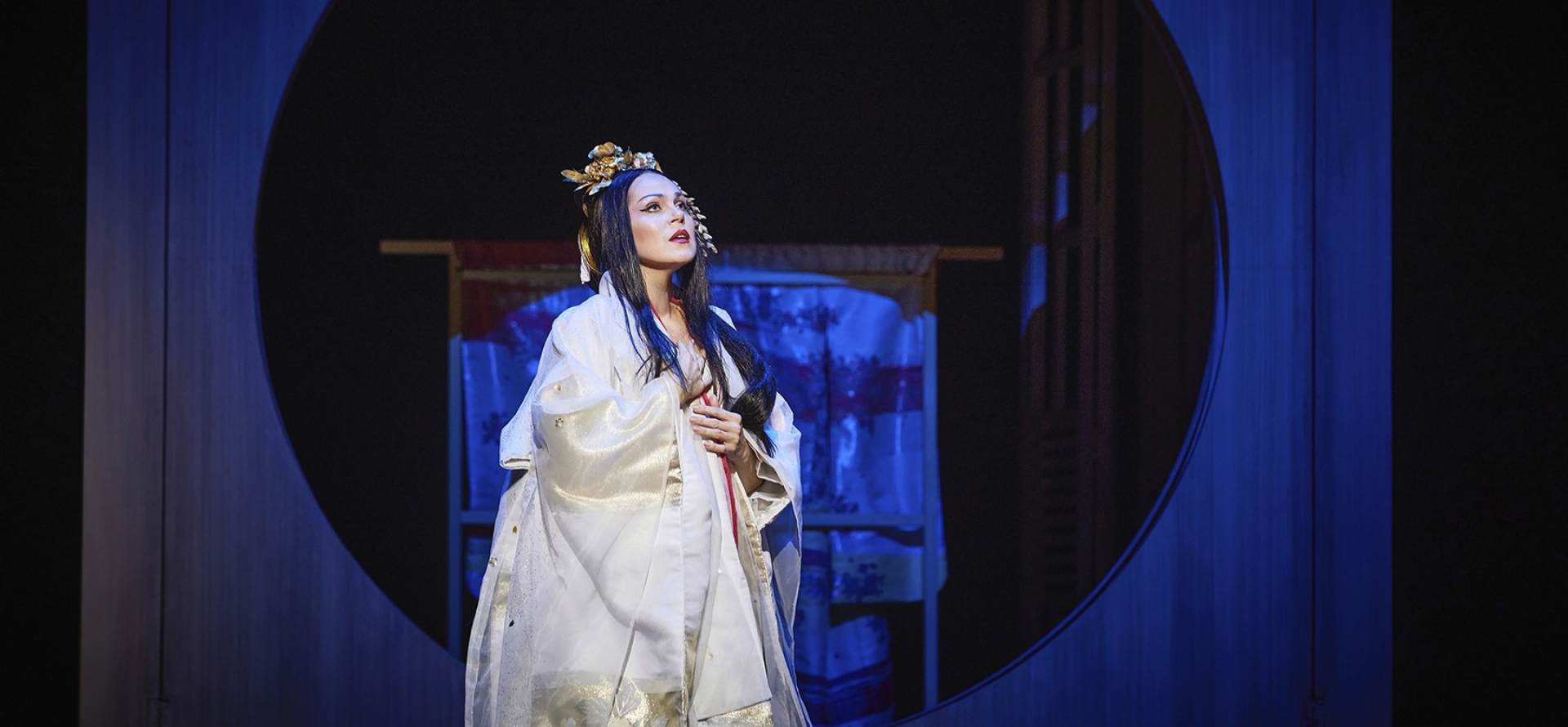
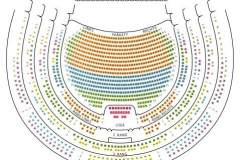 Seating plan
Seating plan 
